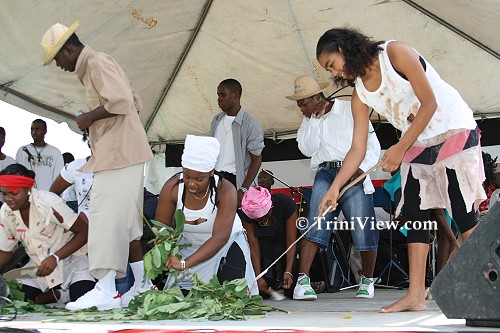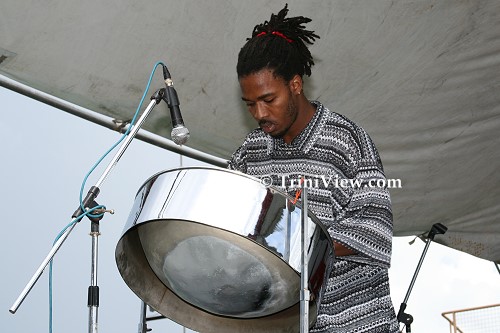 NABAC students
NABAC students
TriniView.com Reporters
Event Date: October 17, 2007
Posted: December 12, 2007
The National Youth Action Committee (NYAC) held its annual Emancipation to Republic Rally on Wednesday 17th October, 2007, at the Jean Pierre Complex in Port of Spain. Primary and secondary school children from across the country, under the supervision of their teachers, came out for this event. Akhenaton Daaga, Servant Director of the National Youth Action Committee told the audience that the event aimed to bring the history of the nation alive through drama, song, dance, monologues and poetry. He expressed that the Republic and the struggle for development lay on the foundation of struggles that include Emancipation, Indentureship and the Water Riots.
Master of Ceremonies Aiyegoro Ome observed that the enslavement of Africans followed the period of enslavement of the Native Peoples, and collectively these two periods represent the worst periods of dehumanization and oppression that has been known to human existence. With respect to the indigenous people of the Americas he said many of them have been wiped out, and those who have survived now are seeking to re-establish themselves. Saying that the perfect slave has never existed, Aiyegoro emphasized that both the indigenous people and Africans resisted at every opportunity.
 NABAC students do a skit on Slavery in the Caribbean
NABAC students do a skit on Slavery in the Caribbean
Students from the National Academy of Business Arts and Computing (NABAC) started the performances with a dramatic skit that depicted slavery in the Caribbean. Calypsonian 'Young Creole', dressed to fit the song, followed up this skit with his dramatic rendition of the Sparrow-sung classic "Slave". Following his performance, NABAC students returned to the stage to perform a dance that depicted the struggle for, and joy of, Emancipation.
The end of slavery and the start of the Indentureship period was marked by the Kishan Seenath Dance Troupe who depicted through dance, the arrival of East Indians to the shores of Trinidad. The Sande Grande Tassa group demonstrated the Indian contribution to the national cultural landscape with a rhythmic Tassa display, continuing to play even as it started to drizzle. Also performing during this segment was Calypsonian Amrika Mutroo who wowed the audience with a splendid performance.
 Talparo Stickfighters
Talparo Stickfighters
The Talparo stickfighters gave an exciting depicting of stickfighting in the era of the Camboulay Riots of 1881 as MC Aiyegoro Ome explained that the British colonial rulers sought to erase African and Indian cultural forms. Belmont Boys' Secondary school also performed an excellent skit that re-enacted the Camboulay Riots. Jagdeo Phagoo continued highlighting the veins of Caribbean resistance with a Pichakaree song in commemoration of the Jahajee Massacre of 1884.
 | | Taharqa Obika does a monologue
on the Water Riots of 1903
| |
Attention was then turned to the Water Riots of 1903 as Aiyegoro Ome shared that the rioters in 1903 completely burned down the Red House. Ome also highlighted the contributions of several persons of that era, including Henry Sylvester Williams, Edgar Smith and Emmanuel 'Muzombo' Lazare who were involved in agitating for certain rights. According to Ome, the leaders of the revolt were members of the Rate Payers Association, who were protesting the plan to place meters on the water coming onto people's land as well as the general attitude of the colonial authorities. Storyteller Taharqa Obika then proceeded to give an interactive monologue titled "Water Riots", which further outlined the circumstances surrounding the Water Riots as the audience joined in repeating the refrain, "Fire in Town, the Red House burn down."
From the Water Riots, next was the beginning of Trade Unionism in Trinidad and Tobago as Ome spoke of Trade Unionism and the Butler Riots and highlighted the contributions of Alfred Richards and the Trinidad Working Men's Association; Christina King; Elma François; Jim Barrette and the Negro Welfare and Cultural Association; Arthur Cipriani; Uriah 'Buzz' Butler; Adrian Cola Rienzi (Krishna Deonarine); and countless of other nameless and faceless fighters for workers rights. Ann Marie Vincent continued this topic by sharing with the audience information about Butler, Rienzi, and Cipriani. The NABAC students came to the stage to dramatize this piece of history as they demonstrated the hardships, low wages, poor working conditions and exploitation faced by working women under colonial rule in the early 1900's and their resistance to these realities.
 Akil Browne plays Sniper's "Potrait of Trinidad"
Akil Browne plays Sniper's "Potrait of Trinidad"
Continuing along the historical timeline, Akil Browne played Sniper's immortal "Portrait of Trinidad" on the tenor to highlight the historical importance of the creation of the Steelpan. A little earlier the Gasparillo Tamboo Bamboo group had given a lively display of the art of Tamboo Bamboo to share with the audience the creation of the art form in 1890. These two connected creations of musical brilliance were important manifestations of the cultural and social resistance of ordinary people during colonial rule.
 | | Amirah Augustine sings "Africa is Calling"
| |
As MC Aiyegoro Ome outlined some of the details surrounding the move from the West Indian Federation to the achievement of political independence by Trinidad, poet Arielle John came to the stage to share a poem that questioned the meaning and significance of Independence given our dependence on foreign forces and entities. Jagdeo Phagoo came to the stage to deal with the theme of Independence from a different perspective with his Pichakaree song "One Love" that advocated for love and cooperation within the country.
The next theme was the 1970 Black Power Uprising and Calypsonian Jervae Caesar came to the stage to render in his own style Black Stalin's "Nothing Eh Strange". Also highlighting this period was young singer Amirah Augustine who sang the moving "Africa is Calling".
MC Aiyegoro Ome completed the historical overview with a look at the declaration of Trinidad and Tobago as a Republic in 1976, bringing to an end the event "From Emancipation to Republic". With many school children in attendance, the event was a success in highlighting important aspects of local history in an exciting manner through the use of poetry, song, drama and dance.
After the event, Akhenaton Daaga of the National Youth Action Committee (NYAC) shared that presenting history in this way catered to the different learning styles that persons may have. Ayanna Gellineau, also of the NYAC, mentioned that the event emphasizes the power of transformation, in that any person in any circumstance can positively change themselves and by extension the country. They further expressed how heartened they were at how the students responded positively to the history of Trinidad and Tobago.
 Gasparillo Tamboo Bamboo group
Gasparillo Tamboo Bamboo group
As the audience filtered out of the stands, the Gasparillo Tamboo Bamboo group got a lively rhythm going as schoolchildren danced and gathered around the group, a fitting tribute to the pioneers of the art form.
NYAC's Emancipation to Republic Rally 2007 pictures:
www.triniview.com/gallery/main.php?g2_itemId=217847
Homepage | NJAC | Emancipation Celebrations | Photo Gallery
|
